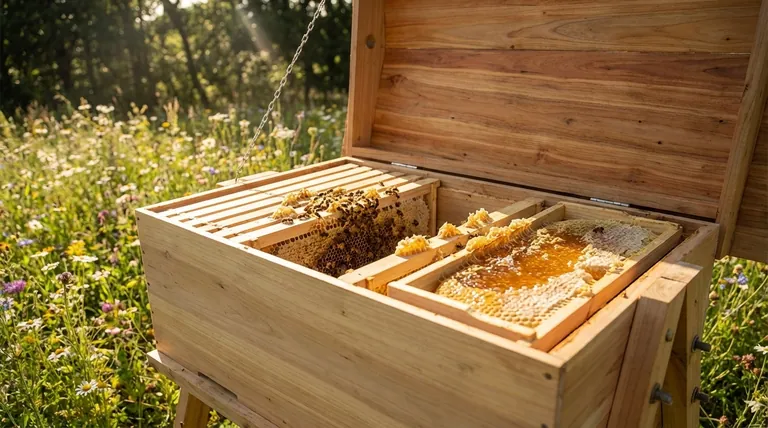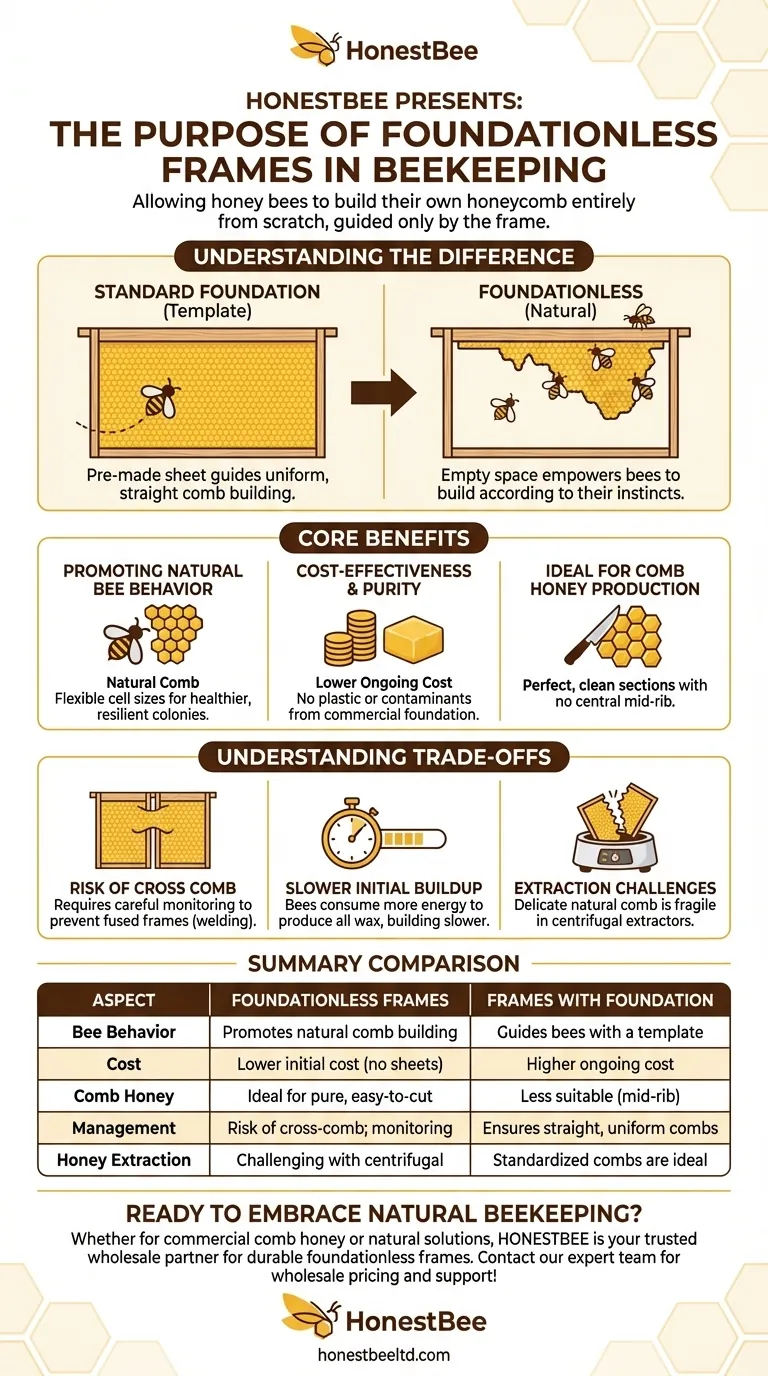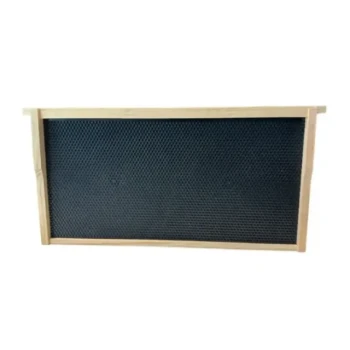The primary purpose of foundationless frames is to allow honey bees to build their own honeycomb entirely from scratch, guided only by the shape of the frame itself. This method stands in contrast to using standard frames that contain a "foundation," which is a pre-made sheet of wax or plastic that gives the bees a construction template.
Choosing foundationless frames is a decision to prioritize natural bee behavior and hive management simplicity over the uniformity and speed offered by traditional foundation. It empowers bees to build comb according to their own instincts and needs.

Understanding the Role of Foundation
To grasp the "why" behind going foundationless, one must first understand what foundation is and the problem it was designed to solve.
The Purpose of Standard Foundation
Standard foundation is a thin sheet of beeswax or plastic imprinted with the hexagonal pattern of honeycomb cells. It acts as a guide, encouraging bees to build straight, uniform combs within the confines of a single frame.
This uniformity is highly valuable for beekeepers who need to inspect hives and extract honey efficiently. It ensures frames can be easily removed without tearing comb built across adjacent frames.
What "Foundationless" Truly Means
A foundationless frame is simply a frame, usually wooden, that contains no pre-made sheet. It provides the bees with an empty space to build.
Most foundationless frames include a guide along the top bar—such as a beveled edge or a thin strip of wood—to encourage the bees to start building their comb in the correct alignment. Many beekeepers also add wires for structural support.
The Core Benefits of Going Foundationless
Beekeepers choose this method for several key advantages that align with a more natural and cost-effective approach to beekeeping.
Promoting Natural Bee Behavior
Without a man-made template, bees build natural comb according to their immediate needs. They have the flexibility to create different cell sizes for workers, drones, and honey storage as they see fit.
Some proponents believe this leads to a healthier and more resilient colony, as the bees are in full control of their nest's architecture.
Cost-Effectiveness and Purity
Foundation sheets, especially those made of pure beeswax, represent an ongoing cost. By omitting them, beekeepers can reduce the expense of setting up new hives.
Furthermore, using foundationless frames made of natural wood ensures that no plastic or potential contaminants from commercial wax foundation are introduced into the hive, which is a major benefit for organic or treatment-free beekeepers.
Ideal for Comb Honey Production
This method is superior for anyone wanting to produce and sell comb honey. Because there is no central plastic sheet or thick wax mid-rib, a knife can cleanly cut a perfect section of honey-filled comb directly from the frame.
Understanding the Trade-offs
While beneficial, going foundationless is not without its challenges. It requires a slightly different management approach and an acceptance of certain realities.
The Risk of Cross Comb
The biggest challenge is cross comb, where bees build comb across multiple frames instead of within a single one. This "welds" the frames together, making hive inspections nearly impossible without destroying the comb and agitating the colony.
Careful monitoring and ensuring the hive is perfectly level are critical to prevent this. Using frames with starter strips or guides helps significantly.
Slower Initial Buildup
Bees must produce all the wax for their comb, which consumes significant energy and resources (in the form of honey). Consequently, a new colony on foundationless frames may build up more slowly than a colony given pre-made foundation.
Challenges with Honey Extraction
The natural comb built on foundationless frames can be less uniform and more fragile. This can make it more difficult to uncap and extract honey using a centrifugal extractor, as the delicate combs may break apart under the rotational force.
Making the Right Choice for Your Apiary
Ultimately, the decision to use foundationless frames depends entirely on your beekeeping goals and philosophy.
- If your primary focus is maximizing honey yield with standard equipment: Traditional frames with foundation are likely more efficient for your operation.
- If your primary focus is natural beekeeping and observing instinctual bee behavior: Foundationless frames are an excellent and rewarding choice.
- If your primary focus is producing and selling pure comb honey: Foundationless frames are the ideal and most practical method.
By understanding these principles, you can confidently decide whether this natural approach is the right fit for you and your bees.
Summary Table:
| Aspect | Foundationless Frames | Frames with Foundation |
|---|---|---|
| Bee Behavior | Promotes natural comb building | Guides bees with a template |
| Cost | Lower initial cost (no foundation sheets) | Higher ongoing cost for foundations |
| Comb Honey | Ideal for pure, easy-to-cut comb honey | Less suitable due to plastic/wax mid-rib |
| Management | Risk of cross-comb; requires careful monitoring | Ensures straight, uniform combs for easy inspection |
| Honey Extraction | Can be challenging with centrifugal extractors | Standardized combs are ideal for extraction |
Ready to Embrace Natural Beekeeping?
Whether you're a commercial apiary focused on high-quality comb honey or a distributor seeking natural beekeeping solutions for your customers, HONESTBEE is your trusted wholesale partner. We supply the durable, well-designed foundationless frames and equipment you need to succeed.
Let's discuss how our products can benefit your operation. Contact our expert team today for wholesale pricing and support!
Visual Guide

Related Products
- Long Langstroth Style Horizontal Top Bar Hive for Wholesale
- Professional Frame Comb Fork and Lifter for Efficient Handling
- Heart-Shaped Comb Honey Frame and Honeycomb Cassette
- Heavy-Duty Stainless Steel Frame Perch
- Heavy-Duty Stainless Steel Clip-On Frame Perch
People Also Ask
- What are the box management requirements for a top bar hive vs. Langstroth? Choose Your Hive Strategy
- How does the design of a top bar hive benefit beekeepers? Ergonomic & Natural Beekeeping for Hobbyists
- What are the benefits of the top bar hive? A Guide to Ergonomic, Natural Beekeeping
- What are the main differences between Langstroth hives and top bar hives? Choose the Right Hive for Your Beekeeping Goals
- What are the benefits of a top bar hive? A Natural, Low-Impact Approach to Beekeeping



















